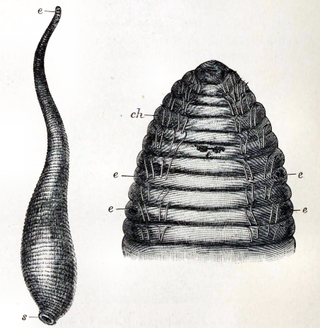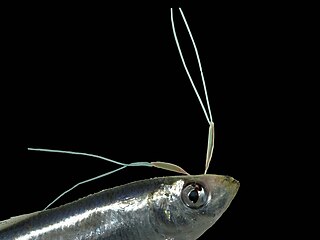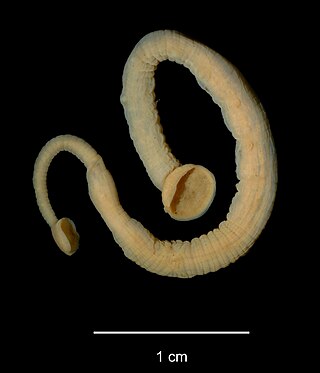
Monogeneans, members of the class Monogenea, are a group of ectoparasitic flatworms commonly found on the skin, gills, or fins of fish. They have a direct lifecycle and do not require an intermediate host. Adults are hermaphrodites, meaning they have both male and female reproductive structures.

Rhynchobdellida, the jawless leeches or freshwater leeches, are an order of aquatic leeches. Despite the common name "freshwater leeches", species are found in both sea and fresh water. They are defined by the presence of a protrusible proboscis instead of jaws, and having colourless blood. They move by "inchworming" and are found worldwide. The order contains 110 species, divided into 41 genera and three families. Members of the order range widely in length, usually between 7 and 40 mm. They are hermaphrodite. The order is not monophyletic.

The yellowbelly flounder is a flatfish of the genus Rhombosolea, found around New Zealand. A different species from the genus Rhombosolea is found in Australia and also goes by the name yellow-belly flounder. The Māori people have commonly fished for R. leporina, and many other species of flatfish, throughout New Zealand's coastal waters for hundreds of years. The Māori name for this species is pātiki tōtara.

The common sole, Dover sole, or black sole is a species of flatfish in the family Soleidae. It is one of the largest fish in the Solea genus. It lives on the sandy or muddy seabed of the northern Atlantic and the Mediterranean Sea where it often partially immerses itself in the substrate. The upper side is greyish-brown while the underside is white. It grows to a maximum length of about 70 cm (28 in). The species is prized as a food fish, being caught mostly by trawling on the seabed.
The silver lamprey is a lamprey commonly found in the Northern and Central United States, as well as a large part of southern Canada. Its binomial name means "sucking fish" in Greek and "one-pointed" in Latin. The silver lamprey is a member of the class Agnatha, sometimes referred to as cyclostomes (round-mouths). Other common names include: bloodsucker, blue lamprey, hitch-hiker, lamper, lamprey eel, northern lamprety. The silver lamprey should not be confused with the sea lamprey, which has caused considerable damage to native fish populations in the Great Lakes region.
Entobdella soleae is a monogenean (Platyhelminth) skin parasite of the common sole, Solea solea, an important food fish. They are approximately 2 to 6 mm in length. It is flat, translucent, and has a large, disc-shaped haptor, a posterior organ used for semi-permanent attachment to the host. Typically, 2-6 parasites are found on wild sole, but in intensive fish farms this can rise to 200-300 parasites per fish, causing skin inflammation and sometimes death of the sole. E. soleae can live up to 120 days in seawater.

Leeches are segmented parasitic or predatory worms that comprise the subclass Hirudinea within the phylum Annelida. They are closely related to the oligochaetes, which include the earthworm, and like them have soft, muscular segmented bodies that can lengthen and contract. Both groups are hermaphrodites and have a clitellum, but leeches typically differ from the oligochaetes in having suckers at both ends and ring markings that do not correspond with their internal segmentation. The body is muscular and relatively solid; the coelom, the spacious body cavity found in other annelids, is reduced to small channels.
Arhythmacanthidae is a family of parasitic worms from the order Echinorhynchida.

Microcotyle is a genus which belongs to the phylum Platyhelminthes and class Monogenea. Species of Microcotyle are ectoparasites that affect their host by attaching themselves as larvae on the gills of the fish and grow into adult stage. This larval stage is called oncomiracidium, and is characterized as free swimming and ciliated.

Argulus japonicus, also known as the Japanese fish louse, is a species of crustacean in the family Argulidae. This species is light brown in colour and may be between 4 and 9 mm long and 3 to 6 mm wide. It has a stumpy tail, and is shaped somewhat like a round shield. The female and male are phenotypically distinct, categorizing them as a dioecious species. Although they are not drastically different, their transparent skin highlights the minor differences such as the different copulatory accessories.

The Egyptian sole is a species of flatfish in the true sole family, Soleidae. It lives on the sandy or muddy seabed of the Mediterranean Sea, and is now colonising the Red Sea. It often semi-immerses itself in the substrate. The upper side is greyish-brown while the underside is white. It grows to a maximum length of about 70 cm (28 in). This fish is used for human consumption and is prized as a food fish. It is caught mostly by trawling on the seabed.

Acanthobdella peledina is a species of leech-like clitellate in the order Acanthobdellida. It feeds on the skin and blood of freshwater fishes in the boreal regions of northern Europe, Asia and North America.

Theromyzon tessulatum is a species of leech in the family Glossiphoniidae. It is a haematophagous (blood-sucking) leech, found in freshwater habitats in Europe.

Lernaeenicus sprattae is a species of copepod in the family Pennellidae. It is a parasite of the European sprat and certain other fish and is sometimes known as the sprat eye-maggot.

Microcotyle donavini is a species of monogenean, parasitic on the gills of a marine fish. It belongs to the family Microcotylidae.

Sparicotyle chrysophrii is a species of monogenean, parasitic on the gills of the marine fish. It belongs to the family Microcotylidae. Its type-host is the gilt-head seabream.
Microcotyle pseudopercis is a species of monogenean, parasitic on the gills of a marine fish. It belongs to the family Microcotylidae.
Diplasiocotyle is a genus which belongs to the family Microcotylidae and class Monogenea. As all Monogenea, species of Microcotylidae are ectoparasites that affect their host by attaching themselves as larvae on the gills of the fish and grow into adult stage. This larval stage is called oncomiracidium, and is characterized as free swimming and ciliated.

Pontobdella muricata is a species of marine leech in the family Piscicolidae. It is a parasite of fishes and is native to the northeastern Atlantic Ocean, the Baltic Sea, the North Sea, and the Mediterranean Sea.

Trachelobdella lubrica is a species of marine leech in the family Piscicolidae. It is a parasite of fish and has a worldwide distribution in the equatorial belt. It was first described in 1840 by the German zoologist Adolph Eduard Grube, the type locality being Palermo, Sicily, in the Mediterranean Sea.













